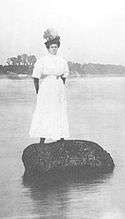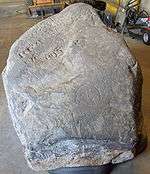Indian Head Rock
The Indian Head Rock is an eight-ton sandstone boulder, which until recently resided in the bottom of the Ohio River.[1]
Etymology

The name Indian Head Rock comes from a carving on the bottom of the boulder with the features of a face present. It has been theorized that the face was carved by a Native American artist as a petroglyph, a boatman as a river gauge, or was carved by John Book from Portsmouth, Ohio who later fought in the Battle of Shiloh.[1] Other theories include that a band of robbers used it to mark their nearby stash and that a quarry man carved the face with a metal device.[2]
History

The Indian Head Rock was used as a carving stone for individuals from the late 19th century to the early 20th century. Others would swim out to the rock to have their picture taken with it. In the 1920s the Ohio River was dammed and 16 feet of water submerged it; it was not until recently that the rock has been seen again.[3]
Removal disputes

(Note the name carvings) Taken 2008.
Recently Steve Shaffer of Ironton, Ohio removed the rock from the bottom of the Ohio River. The Army Corps of Engineers said the rock belongs to Kentucky, and when it was removed, the group from Ohio violated the Federal Rivers and Harborment Act of 1899.[4] In addition, Greenup County, Kentucky Commonwealth's Attorney Cliff Duvall has stated that the Shaffer's removal of the rock from the river may violate Kentucky's Antiquity Act, which is a Class D felony and carries a sentence of one to five years in state prison.[5] On June 19, 2008, a Greenup County grand jury issued an indictment against Shaffer for violating the Kentucky's Antiquity Act by removing Indian Head Rock, which was registered by the University of Kentucky as a protected archaeological object in 1986, without a permit. In addition, Judge William Marshall of the Scioto County Court of Common Pleas sustained an earlier ruling by Greenup County Circuit Judge Bob Conley that then-Portsmouth, Ohio Mayor Jim Kalb and witness Bill Glockner were material witnesses in the case. Based on these rulings, Marshall ordered both men to appear before the Greeunp County grand jury. Kalb and Glockner were scheduled to testify on July 24, 2008.[6]
On Thursday, July 24, 2008, Shaffer appeared before Conely for arraignment in Greenup County Circuit Court. He agreed to appear before the court to avoid being extradited from Ohio. Shaffer's attorney, Michael Curtis, entered a plea of not guilty on Shaffer's behalf to the charge of removing a state registered antiquity without a permit. Shaffer was released on a $5000 signature bond. A pre-trial hearing has been set for October 16, 2008. In addition, Duvall also announced that the grand jury had also issued an indictment against diver David Vetter of Portsmouth.[7] Vetter was also charged with one count of violating the Kentucky Antiquity Act. An arraignment date for Vetter has not been set. Duvall stated that along with the indictments; the grand jury, which has since expired, issued a recommendation that future grand juries continue the investigation.[8]
States
The removal of the rock has also led to the states of Kentucky and Ohio fighting a legislative battle.[9] It has even been suggested by a member of the Kentucky House of Representatives that a raiding party be sent to Portsmouth, where the rock is currently held, to move the rock back to Kentucky. On January 8, 2008, Representative Reginald Meeks introduced House Resolution 12 in the Kentucky General Assembly. The Resolution reads, "Condemn the removal of Indian Head Rock to the city of Portsmouth, Ohio, and urge the city of Portsmouth to return the rock to its original location". On January 22, 2008, House Resolution 12 was adopted by a voice vote.[10]
In May, 2008, Ohio Representative Todd Book, along with sixty-six co-sponsors, introduced and adopted House Resolution No. 137 in the 127th Ohio General Assembly Regular Session. It was resolved, "That we, the members of the House of Representatives of the 127th General Assembly of the State of Ohio, declare that the Portsmouth Indian Head Rock is and has always been inextricably linked to the history of the City of Portsmouth, Ohio, and that it represents an important facet of Ohio's historical connection to the Ohio River, and be it further, That we, the members of the House of Representatives of the 127th General Assembly of the State of Ohio, call upon the Commonwealth of Kentucky to abandon any claims of ownership to the Portsmouth Indian Head Rock and to work with Ohio officials to jointly care for, preserve, and educate the public about the history of the Portsmouth Indian Head Rock and, through such joint action, promote our shared and common history, and be it further, That the Clerk of the House of Representatives transmit duly authenticated copies of this resolution to the Clerk of the House of Representatives of the Commonwealth of Kentucky, the Ohio Historical Society, the Kentucky Historical Society, and the news media of Ohio and Kentucky". [11]
On April 6, 2009, Senior United States District Judge Henry R. Wilhoit Jr. of the Eastern District of Kentucky in Ashland granted motions by the attorneys for Steven R. Shaffer and David G. Vetter to stay the claims against their clients. Wilhoit also ordered that the case be held in abeyance "in its entirety" until after the resolution of the criminal cases.[12]
On July 24, 2009, Duvall filed a motion to dismiss the criminal charges against Shaffer and Vetter. According to Duvall, there has been more than one rock in the river known as "Indian Head Rock" or "Indian Rock" and there is confusion over which is the "official" one. In his 12-page motion, Duvall said he was dropping the case because he would not able to prove beyond a reasonable doubt that the 8-ton boulder that Shaffer and his cohorts pulled out of the river in September 2007 is, in fact, the same Indian Head Rock that was registered with the University of Kentucky as a protected archaeological object in the mid-1980s. "The official Indian Head Rock cannot be in several places at once," the motion states. According to Duvall, Shaffer still faces other consequences for his actions, including being cited by the U.S. Army Corps of Engineers for undertaking a dredging operation without a permit. [13] Judge Conley granted the motion and dismissed the charges on July 30, 2009.
On July 8, 2010 WFPL reported that a settlement had been reached allowing the rock to be brought to Kentucky and stored.[14] The rock was returned to Kentucky on November 4, 2010 and will be held in Greenup County. The rock will not be returned to its original location in the river because the original site "had been compromised." [15]
References
| Wikimedia Commons has media related to Indian Head Rock. |
- 1 2 Barry, Dan (February 11, 2008). "Between States, Hard Feelings Over a Rock's Place". The New York Times.
- ↑ "Fight over boulder known as Indian Head Rock is escalating.". Native News Today.
- ↑ Lavender, Dave (July 6, 2005). "History Uncovered: Ohio River Petroglyphs Revealed". The Herald-Dispatch.
- ↑ Benton, Dave (March 20, 2008). "Controversial Indian Head Rock". WSAZ NewsChannel 3.
- ↑ Yohe, Randy (March 27, 2008). "Controversial Indian Head Rock". WSAZ NewsChannel 3.
- ↑ Hart, Kenneth (2008-06-29). "Ironton Man Indicted in Rock Dispute". The Independent (Ashland, Kentucky).
- ↑ Allen, T.W. "Shaffer pleads not guilty in rock case". The Portsmouth Daily Times.
- ↑ Hart, Kenneth (July 27, 2008). "Shaffer pleads not guilty to theft". The Independent.
- ↑ Hartman, Steve (March 28, 2008). "An Epic Battle Over A Rock". CBS.
- ↑ Meeks, Reginald. "Kentucky House Resolution 12".
- ↑ Book, Todd. "Ohio House Resolution 137". Ohio Legislature.
- ↑ Hart, Kenneth (April 8, 2009). "Judge orders stay in rock suit". The Independent (Ashland, Kentucky).
- ↑ Hart, Kenneth (July 24, 2009). "Charges to be dropped in Indian Rock case". The Independent (Ashland, Kentucky).
- ↑ Bullard, Gabe (July 8, 2010). "Indian Head Rock returning to Kentucky". WFPL.
- ↑ "Kentucky gets disputed rock back from Ohio". The Columbus Dispatch. Associated Press. November 4, 2010. Retrieved November 4, 2010.